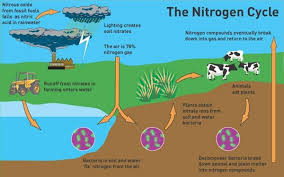
by Bill Schlesinger
Among the tools of the “green revolution,” that has increased crop yields worldwide and allows us to fed nearly 8 billion people, are breeding and genetic modifications of crop plants (GMOs), pesticides, and fertilizer. Each has its proponents and impacts on the environment. Today, I focus on the runoff of nitrogen fertilizer.
In the face of its dramatic impacts on plant growth, what is remarkable about nitrogen fertilizer is how little of it ends up in the food we eat. For example, agriculture in the countryside around Paris, France—its “foodshed”—uses about 21 kg N per Parisian per year, but only about 5 kg of that ends up in their food. A large proportion of nitrogen fertilizer is nitrate (NO3-), which is highly soluble in water. About half of the applied nitrogen is lost to runoff; additional nitrogen is lost to the atmosphere as ammonia and nitrous oxide gases. The average nitrogen-use-efficiency of crop production is about 13%.
In the Midwestern breadbasket of the U.S., nitrogen fertilizers have increased crop yields to the envy of farmers worldwide. Yet, here too, about half of the nitrogen applied is lost to the atmosphere (NH3 and N2O) and to runoff. Global nitrogen transport in rivers is now 37% derived from human activities. Nitrogen transport in the Mississippi River has doubled in the past 100 years, with most of the increase occurring since 1960, when fertilizer applications began in earnest. The greatest losses are seen from areas of low or variable crop yield. Some of the applied nitrogen is retained in agricultural soils where it will be a legacy source for nitrate leaching for many years.
These losses are a significant non-performance cost to farmers and they render a huge toll on water quality downstream, all the way to the Gulf of Mexico. Each summer, the coastal waters off Louisiana harbor significant algal blooms (algae like nitrogen too), which die, sink and decompose, consuming dissolved oxygen in the water column that is essential for fish and shellfish. The Gulf fishermen should be outraged.
Finger-pointing abounds, but there is a smoking gun in the isotopic signature of the nitrogen in the Mississippi, which matches the fertilizer applied in the upper Midwest. Inasmuch as the runoff of nitrogen is an interstate transport problem, managing the application of fertilizer and loss of nitrogen to runoff should be a high priority for the Federal government, pursuant to the Clean Water Act.
Is the EPA up to it?
References
Basso, B., G. Shuai, J. Zhang, and G. P. Robertson. 2019. Yield stability analysis reveals sources of large-scale nitrogen loss from the US Midwest. Scientific Reports doi: 10.1038/s41598-019-42271-1
Byrnes, D.K., K.J. Van Meter, and N.B. Basu. 2020. Long-term shifts in U.S. nitrogen sources and sinks revealed by the new TREND-nitrogen dataset (1930-2017). Global Biogeochemical Cycles, in press.
Esculier, F., et al. 2019. The biogeochemical imprint of human metabolism in Paris megacity: a regionalized analysis of a water-agro-food system. Journal of Hydrology 573: 1028-1043.